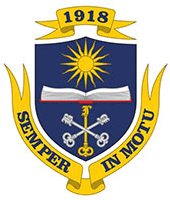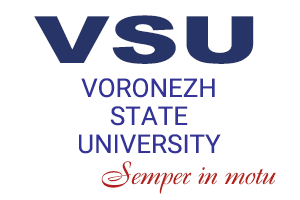Internationalisation Strategy
General Terms
Our internationalisation strategy is a key element of the overall development strategy and an efficient tool to secure our competitiveness in the international educational community.
It is vital to create a university able to respond properly to economic and political challenges and to mitigate them where possible.
To be a modern university means that the international aspect is interwoven in all areas of our activities, from educational and research activities to administrative and organisational activities.
The university views internationalisation as a way to
- improve the quality of all its activities and at all levels of management,
- provide high quality educational and research activities and compliance of education programmes with the modern requirements of the national and international labour markets,
- enhance international competitiveness of educational activities,
- strengthen research capacity and promote its attractiveness on the international market for educational services.
Analysis of the current status of international activities at VSU
The results of an internal analysis which was held within the international Erasmus+ project “Developing Approaches to Internationalisation Strategy Harmonising in the Area of Higher Education, Science, and Innovation in the EU, Russia, Belarus, and Armenia” revealed the university’s strengths and shortcomings in terms of internationalisation. The analysis was held within the following sections:
- Introduction of the Bologna system into the educational process
- Internationalisation of the university’s management system
- Incoming academic mobility
- Outgoing academic mobility
- Internationalisation of academic programmes
- International impact of the university and its position compared to other universities
- Research and educational projects
The analysis revealed the following strengths:
- A positive image of VSU both in Russia and abroad
- High positions in international and Russian rankings
- Convenient geographical location
- Highly qualified academic staff
- Diverse academic programmes (including 170 courses within various academic programmes taught in English; there are also opportunities to complete courses in French and German)
- Developed infrastructure
- Availability of modern information resources (university website with information available in 6 foreign languages (English, French, Spanish, German, Chinese, and Arabic) as opposed to European partner universities where the choice of languages is restricted to English
- Highly qualified staff at the International Cooperation Department
- Participation in bilateral and multilateral international exchange programmes for undergraduate and postgraduate students, academic staff, and researchers
- Organisation of international conferences, symposiums, congresses, and other events
- Participation in international research and educational programmes
- System of curators and social adaptation for international students
The internal analysis showed that the following factors inhibit internationalisation at VSU:
- Discrepancies in academic programmes and evaluation systems, high tuition fees for international students
- Lack of interest in academic mobility programmes
- Shortage of knowledge about the organisation of educational processes abroad
- Low level of students’ engagement in the management of the university
- Insufficient knowledge of foreign languages among university staff members and lack of motivation to teach in English
- Underdeveloped system of long-term partnerships with international invited lecturers
- Insufficient number of joint academic and research programmes with international universities, research institutes, and organisations
- Lack of facilities
- Low level of international publication activities
- Absence of a support and motivation system for research, invention, and the implementation of activities at VSU
Major areas of the action plan for internationalisation
The analysis and VSU strategic development goals was used to develop areas, activities, and indicators of international activities, which were grouped by the nature of their impact:
- Academic activities
- Research activities
- Administrative activities
Mission:
- To train specialists who meet the requirements of the world labour market
- To shape an education environment for the personal and professional development of students by means of switching to student-oriented training
- To contribute to the international learning experience of students at all levels and in different forms
- To increase the number of international students at all levels of education and to achieve a proportional number of exchange students from international universities
- To increase the international competitiveness of the university
| Activities | Mechanisms | Key Results | Target Indicators |
| Implementing network/double degree programmes | Internationalisation of curricula Developing and implementing interdisciplinary academic programmes in cooperation with international partner universities Creating and implementing modular interdisciplinary academic programmes Developing linguistic competences among the university's academic staff Increasing the number of courses in foreign languages Developing innovative teaching and learning projects based on research in humanities and natural sciences Introducing a research-based approach Developing online services for students in the English language Accreditation of academic programmes by international accreditation agencies Performing an international independent expert examination of academic programmes |
Developing, approving, accrediting, and opening joint master’s programmes:
|
Number of joint bachelor’s programmes Total number of students, including international, completing joint bachelor’s programmes Number of joint master’s programmes Total number of students, including international, completing joint master’s programmes Number of courses taught in foreign languages Number of academic programmes taught in foreign languages Number of academic staff members with an intermediate/advanced level of mastering a foreign language (B2, C1, C2) according to the Common European Framework of Reference for Languages in relation to the total number of academic staff members Number of lecturers giving lectures on technical disciplines in a foreign language in relation to the total number of academic staff members |
| Enhancing academic mobility | Improving the implementation of academic mobility agreements, including regular revision of the existing agreements with international universities and their intensification Activities contributing to receiving academic mobility grants (Erasmus+ agreements with international universities) Introducing procedures to recognise time spent training at foreign universities, namely the European Credit system for Vocational Education and Training Actively engaging academic and research staff in academic mobility programmes Providing information support and improving academic mobility opportunities for young researchers Introducing externship opportunities in student mobility programmes |
Developing and implementing academic mobility programmes in the framework of bilateral agreements with leading international universities Cooperation with international universities aimed at preparing projects and receiving Erasmus+ academic mobility grants Recognising over 60% of credits received while studying at a foreign university Agreements with international universities about organising joint practical trainings |
Number of cooperation agreements within which at least one academic exchange has taken place Number of credits to be transferred for each student by the end of the academic mobility programme in relation to the total number of credits Number of credits recognised by the home university at the end of the training period at an international university in relation to the total number of credits within the programme Number of Erasmus+ agreements with international universities Number of lecturers giving lectures at international universities Number of lecturers taking part in academic mobility programmes in relation to the total number of academic stuff members |
| Development of a PR strategy aimed at improving awareness about the university’s academic programmes at the international level | Developing programmes for international themed summer and winter schools Creating short-term test courses for international students to promote university programmes Creating the programme “Education – Science – Production” that allows international master’s students to complete short-term internships in major organisations in the region Developing a strategy for international graduates |
|
Number of summer/winter schools regularly held at the university Number of students taking part in summer/winter schools Number of international participants studying at specified summer school courses Number of events with university graduates among their participants |
Mission:
- To enhance the research outputs of the university
- To intensify innovative activities
- To extend diversity of research areas
- To increase the level of academic staff
- To enhance international research mobility
- To enhance the appeal of university researchers for international employers
- To enhance the appeal of the university as an employer in terms of building a research career at the international level
| Activities | Mechanisms | Key Results | Target Indicators |
| Implementation of research projects with the participation of leading international and Russian scientists or in cooperation with international universities or research institutions | Participation in international research programmes Providing extended information and consulting services concerning international funded programmes |
Implementing international research projects International strategic partnerships for joint research |
Number of international research projects implemented by the university Number of applications submitted for international research contests Number of academic staff members involved in the preparation and implementation of international research projects |
| Enhancing cooperation with international universities, research institutions, and enterprises | Creating international research and training centres in top-priority research areas Flexible research profiling based on regional and global challenges and changes in society and the academic community Creating a research park Active participation in international and European cooperative research networks Holding international research events (scientific and practical conferences, forums, symposiums, and scientific seminars) Staff participation in international research events Publications in international journals Joint publications with international researchers |
Number of joint research centres in top-priority areas in cooperation with international partner universities Number of staff members employed at joint research centres created in cooperation with international partner universities Number of students of different levels who have completed internships at the Research Park Number of international students of different levels who have completed internships at the Research Park Number of international researchers who have conducted research at the Research Park Number of international research events held at the university Number of international research events with the participation of VSU staff |
Mission:
- To develop a shared understanding of and a consistent approach to internationalisation at the administrative level of the university
- To provide a background for the integration of the international element in all areas of the university’s activities
| Activities | Mechanisms | Key Results | Target Indicators |
| Creating a multilevel system for international activities management | Creating and approving the internationalisation strategy as part of the university’s development strategy Developing higher education internationalisation competencies among administrative and academic staff Creating a system of financing international activities Developing a language strategy (ensuring all administrative information is available in the English language, providing orientation in the English language in university buildings and on campuses) Creating an adaptation programme for international students and invited lecturers |
Internationalisation strategy Continuous development and updating of the internationalisation strategy Creating a team of vice-deans for internationalisation Advanced training programmes in intercultural competencies Single translation service |
Action plans for internationalisation Number of administrative and academic staff members who have completed advanced training in internationalisation in Russia and oversees |
| Promoting the university at the international level | Monitoring the university’s positions in international rankings and identifying criteria to evaluate the university’s performance Developing and promoting the concept of strategic partnerships and top-priority regions Membership in international associations, organisations, and clubs Participation in international education weeks and international fairs Holding international informational events (days of international education, etc.) |
Representative offices of the university in countries where we have strategic partnerships | Number of international organisations which the university has membership in Number of international educational fairs which the university has participated in Number of international informational events held at the university Number of international university websites with information about the university and educational and employment opportunities it provides Number of branches/representative offices/centres |
Voronezh State University • 1997–2025

